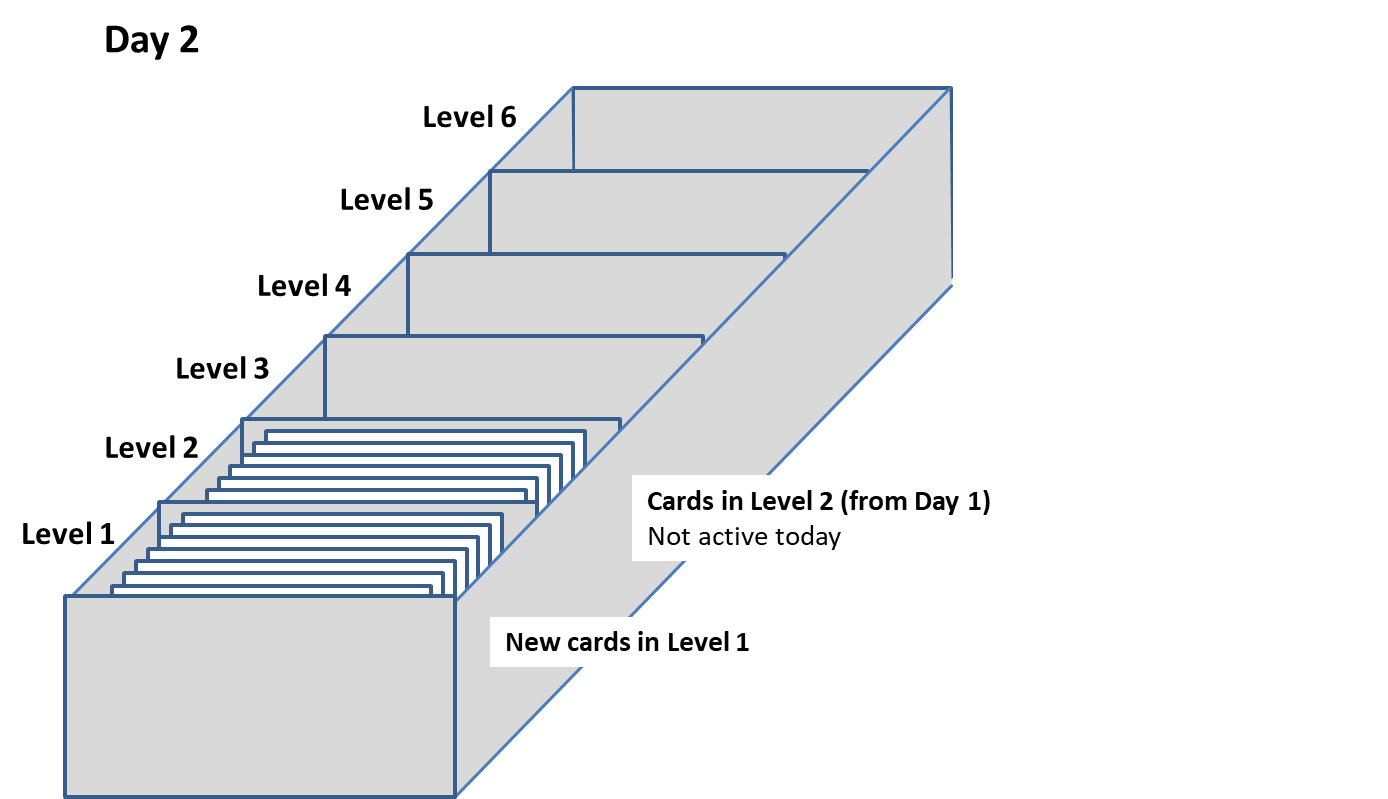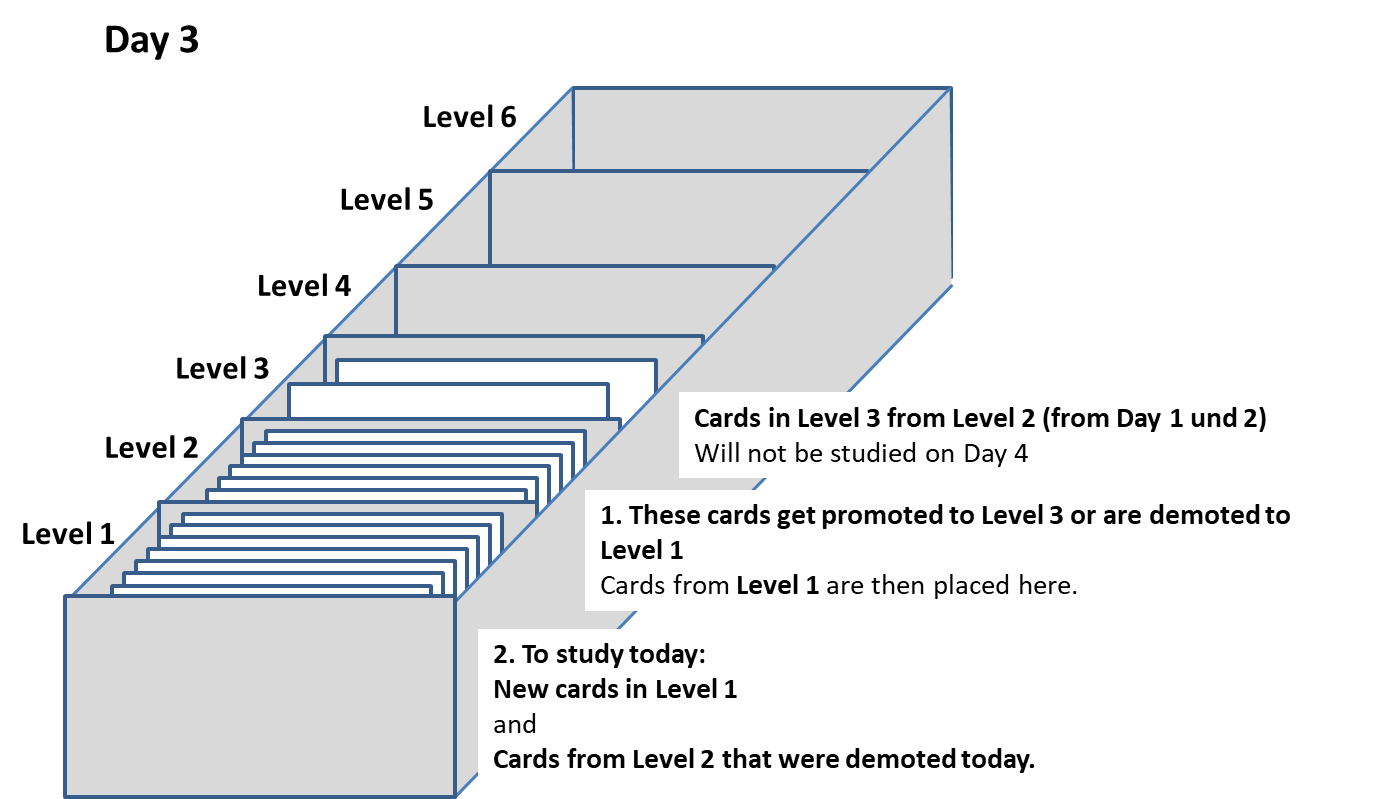More about Learning with Flashcards
The Flashcard Method
This method is used to efficiently anchor new vocabulary in your long-term memory.
While there are online courses and software that offer this method for language learning, you can also apply it using simple means at home.
You need:
- cards on which you can write words / short phrases on both sides
- a box that can be divided into compartments for the cards.
I write the words I want to learn on index cards (or similar) – a word or a short phrase per card, mother tongue on one side, target language on the other.
For example:
Target Language and Native Language
- Target Language
- Native Language
Learning without Native Language Translation
Even better is to learn vocabulary and phrases WITHOUT using one’s native language. I will explaining how to do this in another post.
For now, however, we will remain with the conventional approach.
Seven Levels
Each card eventually goes through seven levels. Once it has left level 7, it is anchored in long-term memory.
To make the organization much easier for me, I get – or construct – a container with seven compartments – one for each level – where I can keep the cards.
First Day
The first cards are stored in Level 1 (front compartment). On this (first) day I will study these cards.

I can also take the cards with me wherever I go. Whenever I have a few minutes, I can go through the cards.
Comprehension
First, I look at the word / phrase of the target language and try to remember the translation.
This is how I learn to comprehend (read and hear) the language.
„Do I understand the words when I see / hear them?“
If I guess a card correctly, I’ll put it aside.
If I have not understood a card correctly, I place it behind the other cards in Level 1. I then study such a few times. As soon as I understand one, I set it aside.
Expression – Reproduction
Now I look at the side of the card with the translation (mother tongue) and try to guess the word / phrase of the target language.
This is how I learn to express myself in the target language (speaking and writing).
This second procedure is helpful because:
If you want to express yourself in the target language, you will (at first) tend to think of the word / phrase in your native language, and then translate it before you say it out loud.
I review the cards as I do for Comprehension.
As soon as I understand one, it finally goes into Level 2.
* If, however, you use the „learning without a mother tongue“ approach, you often only need to study one side of a card (instead of two).
I repeat this entire process with each card, no matter what compartment it is in…
There is, however, an important difference when it comes to cards in the other compartments (see below).
Day Two
I take new vocabulary, write it on cards and learn it exactly as the first set of cards.

These are also “promoted” into Level 2 in the course of the day.
I do not deal with the cards from Day 1, which are already in Level 2, until tomorrow (Day 3)
Day Three
At the beginning of this day, there are cards:
- in compartment 2: the vocabulary of day 1 and day 2 – I will study these today
- in compartment 1: the new vocabulary for today

Today I study cards in the following order:
- the new cards in Tray 1 – as on the first day, and then
- the cards in compartment 2 – procedure as on the 2nd day
The Difference between Level 1 Cards and all other Levels
If a card has reached Level 2 or higher, I „promote“ the card to the next Level ONLY if I recognize / understand the card IMMEDIATELY.
If I do not recognize a card immediately, I study it a few times, then I “demote” it all the way back to Level 1 – no matter what Level it had reached!
So:
- The cards I know go to Level 3.
- The cards I do not know go back to Level 1.
The compartments are always treated in this order:
- The cards at the highest level (in the highest compartment)
- Then the cards in the next highest level
- down to Level 1
The Complete Schedule[1]
It takes – in the best case – 120 days until a card at Level 7 is removed as „done“.
The content of this card is, however, anchored in long-term memory (as long as I actively use the language)!
If you study the cards every day (and always introduce new cards), then a schedule would look like this.
In this example, we assume that we begin on January 1.
| Day | Date | Levels | Note |
| 1 | 01. Jan | 2, 1 | There are, of course, no cards on Level 2 on the very first day. |
| 2 | 02. Jan | 3, 1 | At this point, there are no cards at Level 3. |
| 3 | 03. Jan | 2, 1 | |
| 4 | 04. Jan | 4, 1 | At this point, there are no cards at Level 4. |
| 5 | 05. Jan | 2, 1 | |
| 6 | 06. Jan | 3, 1 | The first cards are now at Level 3. |
| 7 | 07. Jan | 2, 1 | |
| 8 | 08. Jan | 1 | |
| 9 | 09. Jan | 2, 1 | |
| 10 | 10. Jan | 3, 1 | |
| 11 | 11. Jan | 2, 1 | |
| 12 | 12. Jan | 5, 1 | At this point, there are no cards at Level 5. |
| 13 | 13. Jan | 4, 2, 1 | The first cards are now at Level 4. |
| 14 | 14. Jan | 3, 1 | |
| 15 | 15. Jan | 2, 1 | |
| 16 | 16. Jan | 2, 1 | |
| 17 | 17. Jan | 2, 1 | |
| 18 | 18. Jan | 3, 1 | |
| 19 | 19. Jan | 2, 1 | |
| 20 | 20. Jan | 4, 1 | |
| 21 | 21. Jan | 2, 1 | |
| 22 | 22. Jan | 3, 1 | |
| 23 | 23. Jan | 2, 1 | |
| 24 | 24. Jan | 6, 1 | At this point, there are no cards at Level 6. |
| 25 | 25. Jan | 2, 1 | |
| 26 | 26. Jan | 3, 1 | |
| 27 | 27. Jan | 2, 1 | |
| 28 | 28. Jan | 5, 1 | The first cards are now at Level 5. |
| 29 | 29. Jan | 4, 2, 1 | |
| 30 | 30. Jan | 3, 1 | |
| 31 | 31. Jan | 2, 1 | |
| 32 | 01. Feb | 1 | |
| 33 | 02. Feb | 2, 1 | |
| 34 | 03. Feb | 3, 1 | |
| 35 | 04. Feb | 2, 1 | |
| 36 | 05. Feb | 4, 1 | |
| 37 | 06. Feb | 2, 1 | |
| 38 | 07. Feb | 3, 1 | |
| 39 | 08. Feb | 2, 1 | |
| 40 | 09. Feb | 1 | |
| 41 | 10. Feb | 2, 1 | |
| 42 | 11. Feb | 3, 1 | |
| 43 | 12. Feb | 2, 1 | |
| 44 | 13. Feb | 5, 1 | |
| 45 | 14. Feb | 4, 2, 1 | |
| 46 | 15. Feb | 3, 1 | |
| 47 | 16. Feb | 2, 1 | |
| 48 | 17. Feb | 1 | |
| 49 | 18. Feb | 2, 1 | |
| 50 | 19. Feb | 3, 1 | |
| 51 | 20. Feb | 2, 1 | |
| 52 | 21. Feb | 4, 1 | |
| 53 | 22. Feb | 2, 1 | |
| 54 | 23. Feb | 3, 1 | |
| 55 | 24. Feb | 2, 1 | |
| 56 | 25. Feb | 7, 1 | At this point, there are no cards at Level 7. |
| 57 | 26. Feb | 2, 1 | |
| 58 | 27. Feb | 3, 1 | |
| 59 | 28. Feb | 6, 2, 1 | The first cards are now at Level 6. |
| 60 | 01. Mar | 5, 1 | |
| 61 | 02. Mar | 4, 2, 1 | |
| 62 | 03. Mar | 3, 1 | |
| 63 | 04. Mar | 2, 1 | |
| 64 | 05. Mar | 1 | |
| The cycle goes on, since not every card goes through without being „demoted“, and | |||
| new cards are constantly being added to Level 1. | |||
| Thus, the cycle is continued: | |||
| Day 65 = Day 1 | |||
| Day 66 = Day 2, etc. | |||
Continuation
So, new words / phrases are learned every day.
If the number of cards is a bit too much for you, you can, of course, introduce a smaller number of new cards to Level 1.
You can even take a brief time out (no new cards on a particular day).
[1] Source: Gabriel Wyner, Fluent Forever, Harmony Books: 2014



